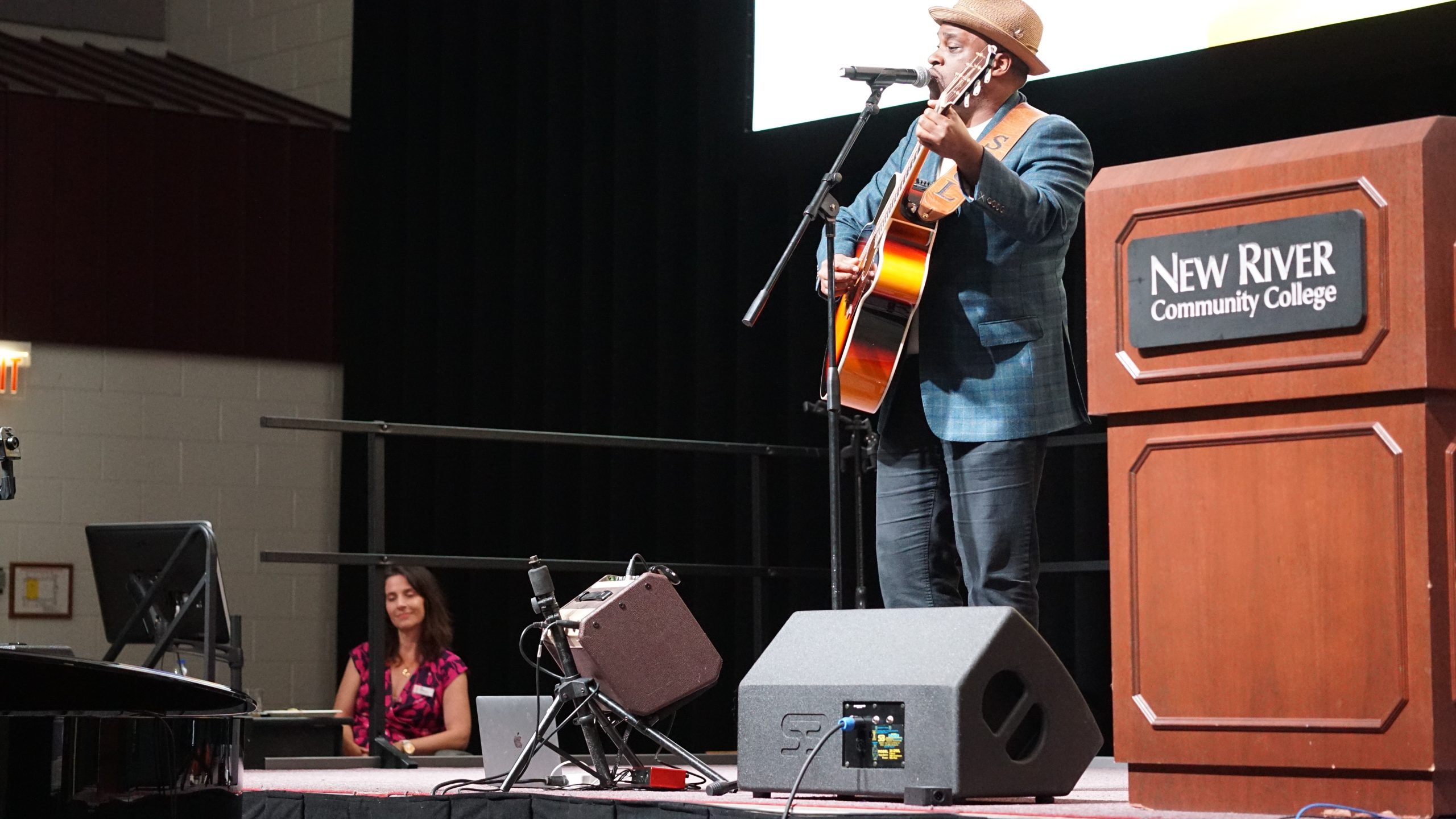A dissertation, a song, and a quilt: Pulaski’s long civil rights heritage


“Cast down your bucket where you are.”—Booker T. Washington
As I pull into my hotel in Pulaski, a train rumbles through the center of town, heading west with a long, colorful load of double stacked shipping containers. Its thunder and whistle, held in by a beautiful brim of mountains, briefly fills this Southwest Virginia town. And then it’s gone and everything seems strangely quiet, as in the aftermath of a fire that’s consumed a building, when the roar and hiss have abated and all that remains is memory, ashes, and an uncertain future. One’s ears recalibrate and Peak Creek’s light, burbling music returns. Then the low swoosh of a car rolling past abandoned, 20th century industrial buildings, whisking someone to work, school, church or on an errand to the Dollar General.
The fire metaphor in my introduction of the town is intentional. I’d been lured the two-and-half hours from Charlottesville, along Interstates 64 and 81, and down the Valley of Virginia by the planned unveiling of a quilt, stitched together not only with thread, but with history, love, and vision. And the story of the quilt begins with a fire that engulfed Pulaski’s rickety, segregated Calfee Training School late on November 10, 1938, and burned into the wee hours of November 11. No one seems to know if the fire was an accident or set intentionally. They do know, however, that the fire department which was across the street didn’t respond for two hours.
You could say, too, that this journey of remembering begins with Dr. N. Wayne Tripp’s 1995 dissertation, Chauncey Depew Harmon, Senior: a case study in leadership for educational opportunity and equality in Pulaski, Virginia, that rescued and documented the history of that fire and the efforts of Pulaski’s brave Black citizens to insist on equality in their schools during the Jim Crow period of legalized segregation. The late Congressman and Civil Rights leader John Lewis said that “Democracy is not a state. It is an act.” History, too, is an act; it’s an act, such as a dissertation, a song, or a quilt, of organizing and transmitting memory. It binds life’s fragments into knowledge that can pass from one generation to the next, informing our choices as citizens.
The past in service to the present
In 2018, Jill Williams together with Dr. Michael “Mickey” Hickman and other alums of the Calfee Training School began a project to guide Pulaski’s community in reimagining what the empty, crumbling space that had once been a source of both community conflict and pride could be today. The vision that emerged attracted partners and funding. Today, Williams is the Executive Director of the Calfee Community and Cultural Center, created to “[revitalize] the legacy of the historic Calfee Training School by serving our community’s present needs in order to create a stronger future”. Those needs include a childcare center and programs to address food insecurity, mental health issues, and continuing education.
“Recent generations in Pulaski have forgotten that slavery and Jim Crow reached into these Appalachian hills and valleys,” says Williams. “Virginia textbooks,” she continues, “focus primarily on the large plantations of the state’s fertile lowlands.” Questions, therefore, about why, historically, some thirty percent of the population in Pulaski was African American go unasked and unanswered.
Growing up in Pulaski, Williams had never heard about the history of the Calfee Training School fire and its connection to the struggle for Black liberation. When she and the Board Members discussed it, they saw an opportunity to recover and celebrate the local history of Black resistance to inequality. They knew that America’s racial history continued to affect their lives; the school board, board of supervisors, and city council in Pulaski are all white today and the local community has documented racial disparities in policing and school punishments. Williams and the Calfee board believe this local history represents a way to teach citizens, and especially young people, not only job skills, but the importance – and power – of civic engagement, how knowing local history can help a community understand where today’s inequities and injustices come from and provide the tools and courage to address them.
“Something’s happening in Pulaski”
Dr. Tripp’s dissertation tells us that in 1938, twenty-five-year-old Chauncey Harmon was the newly appointed principal of the Calfee school when it burned. The local kid had left Pulaski to be educated at the prestigious Tuskegee Institute in Alabama before returning home as a young man ready to make his mark. In May 1938, Harmon attended a teacher conference where the National Association for the Advancement of Colored People (NAACP) issued a call for Virginia teachers willing to make a legal stand against unequal school facilities attended by Black children and pay for Black teachers. Harmon was already rallying support for the NAACP’s legal fight when the fire destroyed Pulaski’s Black school. As he hurried to find classroom space in local churches for some 250 displaced students, he worked with NAACP lawyers to petition the Pulaski County School Board for a better, 11-room school and fair salary adjustments for Calfee’s teachers.
In 1939, the School Board, despite pressure from the NAACP and the Black press, rebuffed the community demands. They tabled the discussion of teacher pay and agreed to build an eight-room school that would cost 35,000 dollars (even as they approved a new, 54,000-dollar gymnasium for the local white elementary school), while offering to bus students who desired an education beyond the seventh-grade to the Christiansburg Industrial Institute in the next county, nearly thirty miles away on country roads. The all-white school board also eliminated the jobs of Chauncey Harmon and another teacher active in the push for equality.
Fighting Fire with Fire
Over the next decade, as the NAACP ramped up its legal struggle against inequality in education, parents in Pulaski were growing tired and frustrated by the time their children spent traveling back and forth to Christiansburg. Those wasted hours kept the commuting students from participating in extracurricular activities or staying late to study in the library.
In 1947, a prominent local doctor, P. C. Corbin, working with renowned Civil Rights lawyers from Richmond, Oliver Hill and Spotswood Robinson, sued the Pulaski County School Board for failing to provide equal educational opportunities to his son, Mahatma. 23 families joined him, representing 54 children. In May 1949, a district court judge dismissed Dr. Corbin’s suit. Six months later, however, the federal Fourth Circuit Court of Appeals with jurisdiction from Maryland to South Carolina found that African American students did indeed face discrimination because of unequal educational resources and facilities, as well as the interminable bus rides.
After more than a decade of taking a dangerous public stand against inequality, Pulaski’s Black community and a team of relentless and brilliant lawyers had won in court. Neither Pulaski County nor the State of Virginia, however, intended to honor the federal court’s decision. In her illuminating book, We Face the Dawn, on Lawyers Hill and Robinson’s fight against Jim Crow, Margaret Edds writes, “Like every other court mandate growing out of the Virginia school equalization campaign, the Fourth Circuit ruling would prove easier to issue than to enforce.”
There was, however, a detail that would prove valuable to the NAACP’s ongoing legal campaigns to dismantle Jim Crow in education. The district judge who’d originally dismissed the 1947 case noted that rural white schools weren’t on the same level as the schools in the county’s towns, writing that “no two schools are ever precisely equal.” Edds reports that Spottswood Robinson responded astutely to the judge’s decision, noting that “The significant consideration is that while some white high school pupils may, all Negro high school pupils must, be subjected to such hardships and inconveniences.” (emphasis added).
This exchange between the judge and Spottswood Robinson helped spark a shift in the NAACP’s legal strategy. After the Corbin v. Pulaski County School Board case, Thurgood Marshall and the NAACP Legal Defense Fund stopped fighting for the equalization of segregated education and started working to desegregate public schools across the South and the Nation. It’s said that two years later, Lawyers Hill and Robinson were on their way to Pulaski to organize a desegregation case, when they learned that Barbara Johns had led a student walkout of the R. R. Moten High School in Farmville. The lawyers rerouted and a Farmville student, rather than a student in Pulaski, would join the Brown v Board of Education case and the 1954, history-altering Supreme Court decision against segregation.
When Williams approached a local quilting group with an idea for a fabric testament to the 1947 suit, several women agreed to take up the challenge of rendering Pulaski’s history in art. Interestingly, the active quilters in the area are mostly white. Though many had social connections to members of the Black families involved in the lawsuit, none had “any idea these families went through what they went through,” says Jenny Shepherd. “I didn’t even know about the lawsuit and now I do,” says Rebecca Miller Ferrell. “We were told,” continues Ferrell, “that the slave ladies [made quilts] for their slave owners. And that makes me feel very special to be able to [make a quilt] for a Black group. It makes me feel important to help them get their history out.” The silence around the case, however, wasn’t only in the white community.
Silence
The current chair of the NAACP’s National Board of Directors, Leon Russell, is from Pulaski and attended the Calfee Training School as a boy in the 1950s and 60s. He has returned to speak at the May 31 gala event where the 23 families and 54 children who joined the Corbin case are to be honored and the quilt unveiled. “No one talked about [the 1949 case],” he says, and his eyes fill, briefly, with tears as he remembers the good things and the hard things about growing up in Pulaski. Until recently, he hadn’t even known about the suit, or that his grandfather and uncle were part of it. When he learned that “a group of people” from his hometown, “motivated by what they saw as discrimination and for their children and future children” had stood up even though doing so carried “risk that could get you killed or fired” and done so in collaboration with the NAACP, the organization he’d worked with for decades, he’d felt exalted. It was a remarkable convergence in a life committed to civil and human rights in the United States and around the world. “You can’t talk about Pulaski without talking about this history,” he says. “This is what makes this country.” One thing you learn from it, he adds, is that “you don’t have to be Jesse Jackson to be a successful advocate.”
But why the silence? Was it frustration at the fact that the 1949 legal victory didn’t really change anything? Or, maybe, self-preservation? Was it not wanting to burden Pulanski’s Black children with the pain of history as Jim Crow ground slowly to an end in Virginia? Perhaps folks didn’t want to trouble relationships with white neighbors, like Mrs. Smith with whom Russell’s grandmother made apple butter. Or maybe it takes an outsider, like Dr. Tripp, to point out that your history matters. Likely it was some combination of these and the fact that life, after the fire’s out and the lawsuit ends, keeps running down the track, leaving little time to dwell on the past.
Steppingstone
As 250 white and Black people filter into the event space at the New River Community College in Pulaski County to embrace their shared history. They pause before the king-size quilt, suspended from a clothing rack. Rich in orange and purple and pale yellow, it looks like a gorgeous scrapbook assembled from 23 panels, one for each of the families involved in the Corbin suit. The family names–Dyer, Peoples, Slaughter, Smith, Truehart, etc. – are spelled out and joined with symbols of family strength and love. In a town where visible public nostalgia includes an anonymous Confederate statue and a giant painted billboard advertising 5-cent Coca-Cola, this quilt is a new and innovative monument: It’s mobile, personal, and more intent on improving the present and future than glorifying an unrecoverable past.
The evening’s MC is Calfee Center board president, Mickey Hickman. No one loves Pulaski and the history of its Black community more than Hickman. He can show you where the pool hall and the barbershop were, the best hills for sledding, the Dew Drop Inn, and Juicies, the nightspot where folks went to dance. He’ll explain the intentional interruption of Jackson Avenue that begins in a white neighborhood, dead ends, and then picks up again with the same name in a black neighborhood. A talented athlete, he loves to point out the field where Black boys and white boys played football and baseball, sometimes together. At the gala the memories flow and people are honored, including the remarkable former Calfee Training School teacher, Dorothy Deberry Venable, who at 94, seems like she’d be ready to jump right back into a second-grade classroom tomorrow. Appalachian storyteller and musician Aristotle Jones sings a rousing tribute to the 23/54 who “risked it all to bring their case.” NAACP Chair Russell challenges the audience not to be content that the quilt has documented their history, but to use it “as a steppingstone” and to stay focused on “where you will take this county and the nation.” The energy in the room is high, inspired, and inspiring.
Leaving the auditorium, I catch the last moments of a sunset flaming deep orange and fire red from behind a silhouetted copse of trees. It looks like nature’s version of the quilt. Watching the light fade to dark, Jill Williams’ remarks that evening come back to me: “We are living in a time when there’s real pressure to whitewash our nation’s history—especially the painful parts about slavery, segregation, and oppression. And while I understand the impulse to shield children from pain, the danger is this: when we don’t teach the hard history, we also don’t get to teach about the everyday heroes who resisted it. And without those stories—stories that are relatable and rooted in community—how do we inspire the next generation of leaders? How do we build a better future?”
The next morning, as I drive the winding Dora Highway out of Pulaski, I pass a small church. The marquee reads “Home of the free, because of the brave.” I doubt the pastor was reflecting on the local Black community’s ongoing freedom struggle when he chose those words, but I am.
For more information about the Calfee Center and the 23/54 Quilt visit: https://calfeeccc.org/

Uncategorized Senior debt, a foundational element of most multifamily property acquisitions and developments, rarely covers the...

The end of the year is one of the most powerful moments to improve your financial life. A few intentional...

When it comes to escaping the grind of work, whether to tend to one’s responsibilities or to simply be, our...